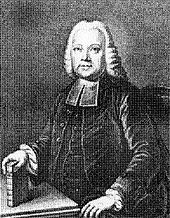Balthasar Haug
Balthasar Haug (born July 4, 1731 in Stammheim near Calw ; † January 3, 1792 in Stuttgart ) was a German humanities scholar and author .
Life
Origin and family
Balthasar Haug is the son of Johann Georg Haug (1694–1776) mayor and clerk to Stammheim and Anna Maria Haug nee Weiß (1694–1777), a daughter of Georg Weiß, farmer and judge in Döffingen .
Visit to the monastery schools of Blaubeuren and Bebenhausen
Balthasar Haug initially received lessons from the local pastor Riderer and continued his school education from 1743 at the Illustre grammar school in Stuttgart before attending the Protestant monastery schools in Blaubeuren and Bebenhausen . From 1751 Balthasar Haug studied theology in Tübingen . His first job as a pastor was in Niederstotzingen in 1757 . In 1762 he was offered a position as rector at the Poeticum Gymnasium in Regensburg , which he refused. In the 1760s he moved to Magstatt as a pastor .
Lecturer at the grammar school illustrious
In 1766, Balthasar Haug officially became professor at the illustrious grammar school in Stuttgart. However, he was only able to fill this position from 1773, as the duke had previously held him in Ludwigsburg with other assignments. There he founded the reading society "Die Literaturfreunde" in 1769 . He lived in Ludwigsburg until 1771. In 1776 he became a professor at the Karlsschule in Stuttgart, then called the Military Academy, which later, in December 1781, received university rank as the Hohe Karlsschule . He taught logic , philosophy , history , German style, mythology and the history of ancient art . A few months after taking up this position, he also became a Wednesday preacher at the Stuttgart collegiate church . As a teacher at the Karlsschule, Balthasar Haug taught, among others, Friedrich Schiller . Haug's son Johann Christoph Friedrich Haug , who was also educated at the Karlsschule, later mediated the contact between Schiller and Johann Friedrich Cotta .
Awards and memberships
A poem on Maria Theresia earned Balthasar Haug the title of crowned poet in 1761. In the same year he became a member of the German Society in Helmstedt and the Society of Liberal Arts in Leipzig . In 1768 he became an honorary member of the Württemberg Académie des arts , in 1769 by Prince von Fürstenberg court and palatine count, in 1771 a member of the Latin Margravial Society of Baden, 1773 a member of the Jena German Society.
Works
Balthasar Haug published numerous writings. In 1762 he published the state of the beautiful sciences in Swabia in Ulm , in 1771 an attempt was made to create a Litterar history of the ancients in tables , in 1779 Professor Haugen's sentences on German language, writing style and taste were published . His book The learned Wirtemberg from 1790, an overview of the country's writers , became particularly well known . It was reissued about 200 years after it was first published. In 1785 he brought out The Antiquities of the Christians .
literature
- Hermann Fischer: Haug, Balthasar . In: Allgemeine Deutsche Biographie (ADB). Volume 11, Duncker & Humblot, Leipzig 1880, p. 50 f.
- Robert Uhland: Haug, Balthasar. In: New German Biography (NDB). Volume 8, Duncker & Humblot, Berlin 1969, ISBN 3-428-00189-3 , p. 88 f. ( Digitized version ).
- Uli Rothfuss , Authors Books Calw. A thousand years of literary and intellectual history in Calw and Hirsau , Tübingen 2001, ISBN 3-87407-383-1 , p. 28 f.
Individual evidence
- ↑ http://www.teachsam.de/geschichte/ges_deu_1648-1790/wuert_carl_eugen/ges_wuertt_carl_eugen_9_3_3.htm
| personal data | |
|---|---|
| SURNAME | Haug, Balthasar |
| BRIEF DESCRIPTION | German writer and humanities scholar |
| DATE OF BIRTH | 4th July 1731 |
| PLACE OF BIRTH | Stammheim (Calw) |
| DATE OF DEATH | January 3, 1792 |
| Place of death | Stuttgart |

